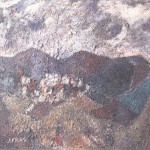JOSÉ FRAU
 He was born in Pontevedra in 1898. During his childhood and youth he lived in different towns such as San Feliú de Guixols. He studied Painting in Huelva in 1912 with Antonio de la Torre and Eugenio Hermoso. In 1916 he moved to Madrid and entered the San Fernando School of Fine Arts. There he studied with Muñoz Degrain.
He was born in Pontevedra in 1898. During his childhood and youth he lived in different towns such as San Feliú de Guixols. He studied Painting in Huelva in 1912 with Antonio de la Torre and Eugenio Hermoso. In 1916 he moved to Madrid and entered the San Fernando School of Fine Arts. There he studied with Muñoz Degrain.
In 1917 he attended the National Exhibitions in Madrid, and in 1918 he held his first individual exhibition at the Galería Layetanas in Barcelona. In this same year he obtained the scholarship to participate in the first El Paular Exhibition. In 1925 he joined the Iberian Artists Society, with which he exhibited in the Buen Retiro Gardens in Madrid and in Paris.
In 1929 he married one of his disciples, Margarita González Giraud, who would often sign her works with the surname of her husband, and with whom he exhibited jointly in 1933.
In 1947 he traveled with his family to Buenos Aires. In 1950 he traveled to Mexico where he took up residence for him and maintained ties with Mexican mural artists such as Sequeiros, Orozco, Ribera and Tamayo, and with Spanish exiles such as Arturo Souto.
In 1966 he returned to Spain and settled in Olmeda de las Fuentes where he remained until his death in 1976 with his wife who continually encouraged and supported him. He made multiple representative paintings of the municipality
He has been considered as one of the representatives of the equivalent of "magical realism" in Spain. His pictorial work is based on figurative premises and a naturalistic and symbolic formation. He participated in the renewal process of Spanish painting in the 1920s and 1930s, evolving towards a post-impressionist style. Later he focused on a calm post-Cezannian modernity where he portrayed landscapes with figures recreated in fantastic and magical environments. During the postwar years he returned to a looser and more nervous brushwork.
In his last works, he used a Fauvist color palette in which very contrasting greens, blues, earths and blacks predominated, while a progressive process of stylization took place in his works in addition to the loss of the protagonism of the human figure.
Back to the list of painters of the Olmeda >>
Galería de Imágenes
 EN
EN Español
Español




